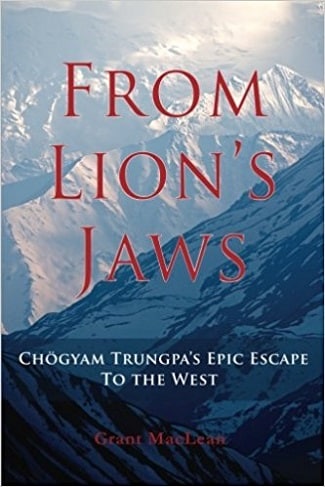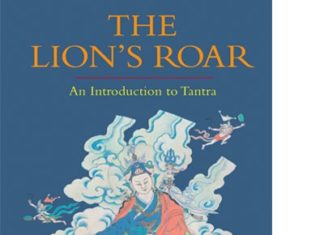
Forty years ago, you could rent a top bunkbed in the Marpa House basement in Boulder for $4 a night. What a deal! Fresh out of college, looking for a job in this cool little town, I grabbed it. I’d heard that Allen Ginsberg and other Beats were teaching at a new little college – Naropa, it was called. I didn’t know that Marpa House and Naropa were Buddhist and didn’t know the difference between Buddhism and Hinduism – all Eastern, right?
But Marpa House, a former fraternity house, was, in fact, Buddhist, and required an hour of sitting meditation a day. My feeling was, for $4 a day, why not? After a week, I noticed a slight but welcome spaciousness pervading my mind, like a complex tangle being weeded. And over pots of tea and bottles of beer in the dining room, I heard stories of the man at the center of all this. Chögyam Trungpa, Rinpoche, it seemed, was a Tibetan lama – a startlingly exotic identity back then. He was a guru—and at this I pictured a benign, white-haired gentleman, wise, kindly and a bit clueless. But no, the others at the dining table were quick to paint another picture altogether—magnetic, puckish, unexpected, an inveterate drinker of alcohol and lover of women, a man with humor and authority, constantly quoted. The situations—the scene—he was creating seemed all-encompassing, boundless, with groups and clubs and schedules and teachings that everybody went to, built their lives around.
My first weekend, I sat all morning at a nyinthun at Karma Dzong on Pearl Street, sitting, walking in a circle, sitting. Wrung out—3 hours!—I hid out in the Marpa House sunroom, curled up on the big couch, and read Born in Tibet, Chögyam Trungpa’s autobiography. The story drew me in: a world high in the Himalayas, of a boy taken from his mother, often lonely growing up in a monastery, raised sternly and with high expectations—traveling on horseback across the vast snow ranges to find his own teacher, gradually realizing the great threat posed by the encroaching Chinese and escaping by foot over the mountains into the safety of India, and an unimaginably new life.
The escape, as described by Chögyam Trungpa in his story, took some nine months. Hundreds of people, including old people and children, went along. The snow was so deep that the strongest men created pathways by flattening themselves, full-length, one after another. They climbed down from a high, sheer cliff on a ladder consisting of a tall pine trunk with narrow carved footholds: a slip, and they would tumble to their deaths into swirling rapids. They got lost in the wilds, they ran out of food and had to eat stewed leather cut from their packs, they were in constant fear of encountering Chinese soldiers. At the top of mountain passes, they cried “Lha gyel lo!” and Trungpa Rinpoche, in the midst of the hardships, encouraged them all to think of the trek as a pilgrimage, a sacred journey.
In Born in Tibet, Chögyam Trungpa tells his story in a measured way – a “matter-of-fact” style, in MacLean’s words. There was high drama, but the trauma, the pain, is downplayed. To me, naively, it seemed like a grueling but incredible adventure—enviable, in a way.
But MacLean, a longtime student of Chögyam Trungpa, Rinpoche, felt there was a major story left untold in the Born in Tibet account of the escape. Eleven years ago, playing around with a flight simulator program, he located one of the mountain landmarks of the journey—and then another and another. He mapped the route, using the maps and narrative of Born in Tibet and was struck by the magnitude and difficulty of the trek. He also saw how truncated the account in Born in Tibet was. Trungpa Rinpoche, MacLean writes, probably played down the tale, in part to protect people still at Surmang and those in the escape party who’d fallen away and found shelter in villages along the route.
With the help of friends, MacLean made a video of the simulated journey, and then, engrossed, traveled to Nepal, Scotland and the United States to interview Tibetan survivors of the escape. These included, in particular, Yonten, Trungpa Rinpoche’s personal attendant, who had accompanied him and had watched over him, saving him scrapings of tsampa when all provisions were exhausted.
Altogether, From Lion’s Jaws, is a deeply researched and highly detailed recounting of the escape—the build-up to the flight, the circumstances, the people, the geography, and the hardships. By reading From Lion’s Jaws, it became clear that Chögyam Trungpa’s escape wasn’t just grueling and certainly wasn’t an enviable adventure—it was harrowing, demanding beyond comprehension, and often tragic.
“For nine months,” MacLean writes in the prologue, “… Rinpoche had evaded the Communists and led a large and growing group of refugees … they [trekked] through some of the world’s fiercest weather and most harshly spectacular landscape. Frequently at breath-grabbing altitudes, often in heavy rain, mist or snow, towards the end in near-Arctic conditions of winter, they slogged through deep snow, swamps and nearly impassable boulder-strewn valleys, crossing countless mountain ranges … when food ran out and they began to starve, they were forced to travel at night to avoid discovery.”
MacLean has done a great deal of meticulous reporting and built his story like an architectural structure. His story is built on both careful geographic research into the route and the terrain, and in-depth interviews with surviving members of the escape party. His reporting took him to Scotland, to interview Lama Yeshe, the brother of Akong, Chögyam Trungpa’s boyhood friend, and to Nepal, for weeks of conversation with Yonten, Trungpa’s attendant, who was with him at every step of the escape and hoarded scraps of tsampa for him when the food supplies were exhausted. As a result, From Lion’s Jaws is full of vivid, concrete details of the events leading up to the escape, and the escape itself—the confusion, the disagreements, decisions, fears, conflicting and helpful personalities and staggering physical and emotional demands.
The stories of the flight are boggling. Some 300 people, including children, old people and mothers with babies, spent months climbing some of the world’s highest mountains. They had no maps or navigation tools. Nobody in the group had ever been to India, the goal. They had only a vague idea of its direction. The food dwindled and then ran out. They kept pushing. They were starving. At points, the snow was waist-deep. The danger of being spotted, and shot or arrested by Chinese soldiers was constant, so no fires were allowed. People slept in the snow. They woke to push on further.
Many of the 300 escapees died. Many just disappeared. Some found refuge with villages along the way. Others fell by the way and perished in the snow. Some of the stories in the book are particularly wrenching, like that of a little group of people, too enfeebled to go any further, taking shelter in a cave. Friends walled them in to protect them from snow and wild animals, and, helplessly, left them there to die.
Some years later, when Chögyam Trungpa was in America, teaching and creating the Buddhist world that drew in so many people, the success of his escape could seem natural, obvious—necessary. But in fact, it was highly edgy. It could have gone disastrously wrong in numerous ways, and it is practically a miracle that it didn’t. There were enormous obstacles—the Chinese military, of course, the prospect of freezing and starving, the weather, and the relentless and arduous nature of the journey. But also there were other, unexpected problems, in the way of interfering friends. Tsethar, the powerful bursar of Surmang, was blind to danger of the Chinese until it was almost too late. First, he constantly pressured Trungpa Rinpoche to return to his monstery, where he would have been arrested—and then, realizing that he, too, had to flee, spent the journey giving bad advice. Another lama, Yag Tulku, spread the news of Trungpa Rinpoche’s plans to escape, after specifically being told to keep them quiet. Hundreds of people then begged to join the escape party. Trungpa Rinpoche couldn’t turn them away. But that huge and unwieldy crowd of escapees created big headaches for Trungpa Rinpoche as the leader, and endangered the safety of all.
From Lion’s Jaws covers the journey to its end—the long route, over the rivers, the peaks, the nights in the snow, the icy ranges. There are numerous memories: a young woman, Palya, crossing the Brahmaputra river in a hastily constructed coracle, dodging bullets from Chinese guns, and shortly after, in the chaos on the other shore, realizing, horrified, that her five-year-old sister was lost. There are even, in the worst conditions, recollections of little jokes: sitting in the snow, in frozen clothes that had gotten wet crossing the river, Chögyam Trungpa managed to tease Akong about traveling with too much baggage, which he had had to jettison. Another time, when Yonten suggested that they all practice tummo, heat yoga, to keep warm, Trungpa Rinpoche pointed out, sardonically, that the heavy breathing noise would give them away.The Chronicles of Chögyam Trungpa Rinpoc…
MacLean’s story follows Chögyam Trungpa into India—the wilds of Nagaland, Himachal Pradesh in the Himalayas and Delhi. There, in the Tibetan refugee camps, there was the suffering of the aftermath of the arduous escapes—heat, sickness and the difficulties of adjusting to a new world, a new life. He met and became close to Freda Bedi, the Englishwoman who became the first ordained Western nun, and through her found his way to Oxford, Scotland and finally America. Like the story of the escape, the chapters on Trungpa Rinpoche in India fleshed out the spare points in Born in Tibet, describing his meetings, his travels, and his impressions.
Whether or not you knew Chögyam Trungpa in his final adventure—that of planting Dharma in the West, From Lion’s Jaws is a wild tale, a thoroughly researched story of a super-life. It fills in the outlines in full color—and it leaves the reader amazed at all that Trungpa Rinpoche endured and accomplished, before turning 21, before even beginning the rest of his life’s work.
______
Visit fromlionsjaws.ca
______
















